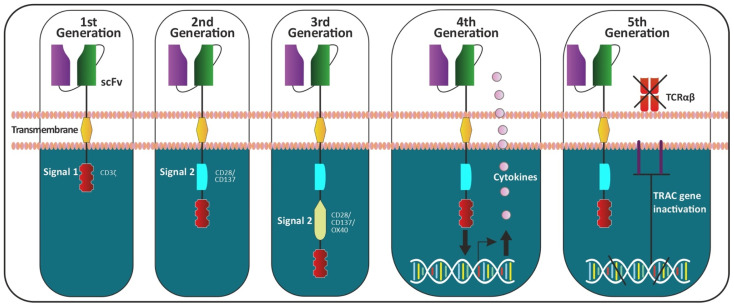Figure 1.
Generation of CAR-T cells. The CAR-T cells are composed of three components: (i) extracellular domain: antigen-recognition domain is a single-chain fragment variant (scFV) fusion protein of the variable regions of the heavy (VH) and light chains (VL) of immunoglobulins, an antigen-specific immunoglobulin separated by a flexible linker, (ii) the transmembrane domain and (iii) the intracellular domain (endodomain: containing several functional units). Initial efforts were made to include only one intracellular signal component CD3ζ (which contains three immunoreceptor tyrosine-based activation motifs (ITAMs), which is important for signal transduction) in the first generation of CARs. The second generation was composed with an addition of a single costimulatory molecule (CD28 or 4-1BB) to the first generation. Various groups co-founded this preclinical research to determine the efficacy projected by including co-stimulatory receptors. The combining of two separate co-stimulatory domains to the second generation of CARs led to the evolution of the third generation of CARs. The fourth generation of CAR-T cells can activate the downstream transcription factor to induce cytokine production (constitutively or inducible expressing inflammatory cytokine: IL-12 or IL-18). These T cells are also referred to as T cell redirected for universal cytokine-mediated killing (TRUCKs). The fifth generation of CARs, based on the second generation, uses gene editing for the insertion of CAR (CRISPR/Cas9) into the TRAC gene for inactivation, leading to the removal of the TCR alpha and beta chains.

